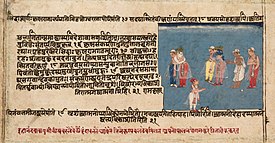
Back البهاغافاتا بورانا Arabic البهاجافاتا بورانا ARZ Bhagavata Purana BCL Бхагавата Пурана Bulgarian श्रीमद्भागवत Bihari ভাগবত পুরাণ Bengali/Bangla Bhágavatapurána Czech Bhagavatapurana German Bagavata Purano Esperanto Bhagavata-purana Spanish
| Part of a series on |
| Vaishnavism |
|---|
 |
| Part of a series on |
| Hindu scriptures and texts |
|---|
 |
| Related Hindu texts |
The Bhagavata Purana (Sanskrit: भागवतपुराण; IAST: Bhāgavata Purāṇa), also known as the Srimad Bhagavatam (Śrīmad Bhāgavatam), Srimad Bhagavata Mahapurana (Śrīmad Bhāgavata Mahāpurāṇa) or simply Bhagavata (Bhāgavata), is one of Hinduism's eighteen major Puranas (Mahapuranas) and one of the most popular in Vaishnavism.[1][2] Composed in Sanskrit and traditionally attributed to Veda Vyasa,[3] it promotes bhakti (devotion) towards Krishna,[4][5][6] an avatar of Vishnu, integrating themes from the Advaita (monism) philosophy of Adi Shankara, the Vishishtadvaita (qualified monism) of Ramanujacharya and the Dvaita (dualism) of Madhvacharya.[5][7][8][9] It is widely available in almost all Indian languages.
The Bhagavata Purana, like other puranas, discusses a wide range of topics including cosmology, astronomy, genealogy, geography, legend, music, dance, yoga and culture.[5][10] As it begins, the forces of evil have won a war between the benevolent devas (deities) and evil asuras (demons) and now rule the universe. Truth re-emerges as Krishna (called "Hari" and "Vāsudeva" in the text) first makes peace with the demons, understands them and then creatively defeats them, bringing back hope, justice, freedom and happiness – a cyclic theme that appears in many legends.[11]
The Bhagavata Purana is a central text in Vaishnavism.[12] The text presents a form of religion (dharma) that competes with that of the Vedas, wherein bhakti ultimately leads to self-knowledge, salvation (moksha) and bliss.[13] However the Bhagavata Purana asserts that the inner nature and outer form of Krishna is identical to the Vedas and that this is what rescues the world from the forces of evil.[14] An oft-quoted verse (1.3.40) is used by some Krishna sects to assert that the text itself is Krishna in literary form.[15][16]
The text consists of twelve books (skandhas or cantos) totalling 335 chapters (adhyayas) and 18,000 verses.[15][17] The tenth book, with about 4,000 verses, has been the most popular and widely studied.[3] It was the first Purana to be translated into a European language, as a French translation of a Tamil version appeared in 1788 and introduced many Europeans to Hinduism and 18th-century Hindu culture during the colonial era.[6][18]
The Bhagavata Purana has been among the most celebrated and popular texts in the Puranic genre, and is, in the opinion of some, of non-dualistic tenor.[19][20] But, the dualistic school of Madhvacharya has a rich and strong tradition of dualistic interpretation of the Bhagavata, starting from the Bhagavata Taatparya Nirnaya of the Acharya himself and later, commentaries on the commentary. The Chaitanya school also rejects outright any monistic interpretation of the purana.
- ^ Thompson, Richard L. (2007). The Cosmology of the Bhagavata Purana 'Mysteries of the Sacred Universe. Motilal Banarsidass Publishers. p. 10. ISBN 978-81-208-1919-1.
- ^ Dominic Goodall (1996), Hindu Scriptures, University of California Press, ISBN 978-0520207783, page xli
- ^ a b Bryant (2007), pp. 112
- ^ Sheridan (1986), p. 53.
- ^ a b c Kumar Das (2006), pp. 172–173
- ^ a b Bryant (2007), p. 111–113.
- ^ Brown (1983), pp. 553–557
- ^ Sheridan (1986), pp. 1–2, 17–25.
- ^ Katz 2000, pp. 184–185: "The five classical Vaiṣṇava schools (sampradāyas) recognize the authority of this devotional text, and each school has accordingly produced commentaries to demonstrate the Bhāgavata's support of its particular views–the Viśiṣṭādvaita school of Rāmānuja (eleventh century), the Dvaita school of Madhva (thirteenth century), the Dvaitādvaita school of Nimbārka (twelfth-thirteenth century), the Śuddhādvaita school of Vallabha (sixteenth century), and the Gauḍīya Vaiṣṇava school of the Gosvāmins (sixteenth century)."
- ^ Rocher (1986), pp. 138–151
- ^ Gupta & Valpey 2013, pp. 3–19.
- ^ Constance Jones and James Ryan (2007), Encyclopedia of Hinduism, Infobase, ISBN 978-0816054589, page 474
- ^ Kumar Das (2006), p. 174
- ^ Barbara Holdrege (2015), Bhakti and Embodiment, Routledge, ISBN 978-0415670708, page 114
- ^ a b Barbara Holdrege (2015), Bhakti and Embodiment, Routledge, ISBN 978-0415670708, pages 109–110
- ^ "ŚB 1.3.40". vedabase.io. Retrieved 2 September 2020.
- ^ Richard Thompson (2007), The Cosmology of the Bhagavata Purana 'Mysteries of the Sacred Universe', Motilal Banarsidass, ISBN 978-8120819191
- ^ Jean Filliozat (1968), Tamil Studies in French Indology, in Tamil Studies Abroad, Xavier S Thani Nayagam, pages 1–14
- ^ Thompson, Richard L. (2007). The Cosmology of the Bhagavata Purana 'Mysteries of the Sacred Universe. Motilal Banarsidass Publishers. p. 10. ISBN 978-81-208-1919-1.
- ^ Dominic Goodall (1996), Hindu Scriptures, University of California Press, ISBN 978-0520207783, page xli

